| Tweet | Follow @OphirGottlieb |  |  |

YHOO is trading $42.47, up 2.9% with IV30™ up 1.6%. The Symbol Summary is included below.
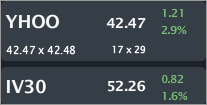
Provided by Livevol
Conclusion
This is a stock, volatility and fundamentals note in a stock that has just hit an eight-year high, has exploding volatility (forward looking risk) and some fundamental measures that may be contributing to the risk. keep in mind as well that YHOO owns a 23% stake in Alibaba (BABA), which will be the largest IPO ever.
Before we get into all of it, let's just start with one eye-popping chart. This is YHOO's stock price vs. Net Income (earnings) for the last ten years. For the most recent year, earnings have dropped again, while the stock price has not reverted to the mean. Risk is here... and a takeover may be priced into the options.
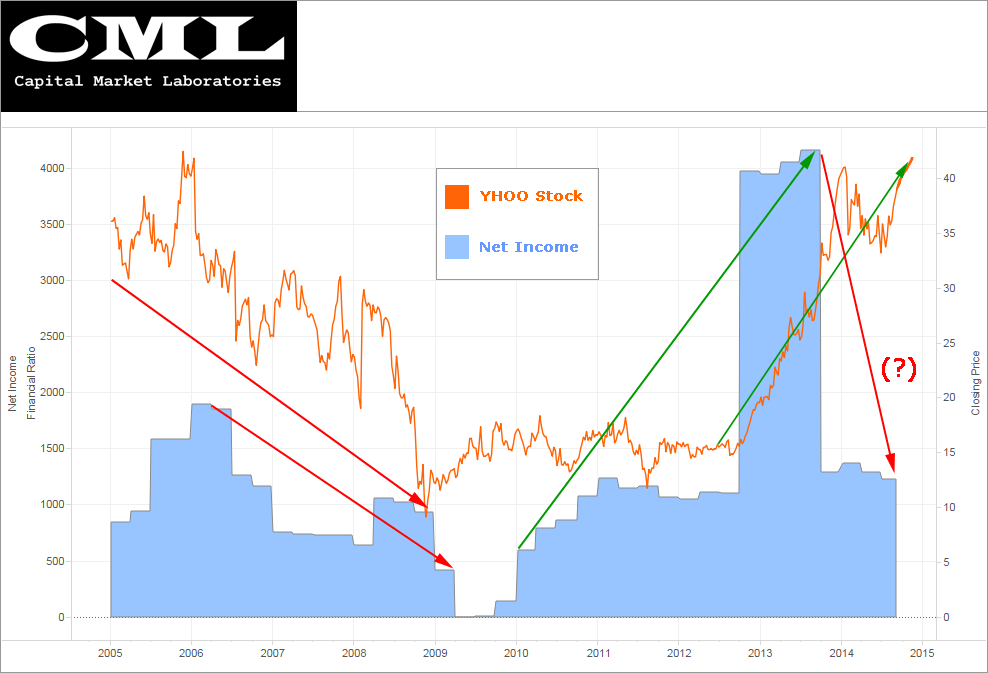
Let's turn to the two-year stock price.

Provided by Livevol
YHOO is up 173% over the last two-years outperforming essentially every large cap tech stock not named NFLX or FB. The rage is about YHOO's ownership stake in Alibaba (BABA), which will likely be the largest IPO ever.
Before we turn to any fundamental measures of YHOO, let's turn to the risk. The IV30™ chart in isolation, below.
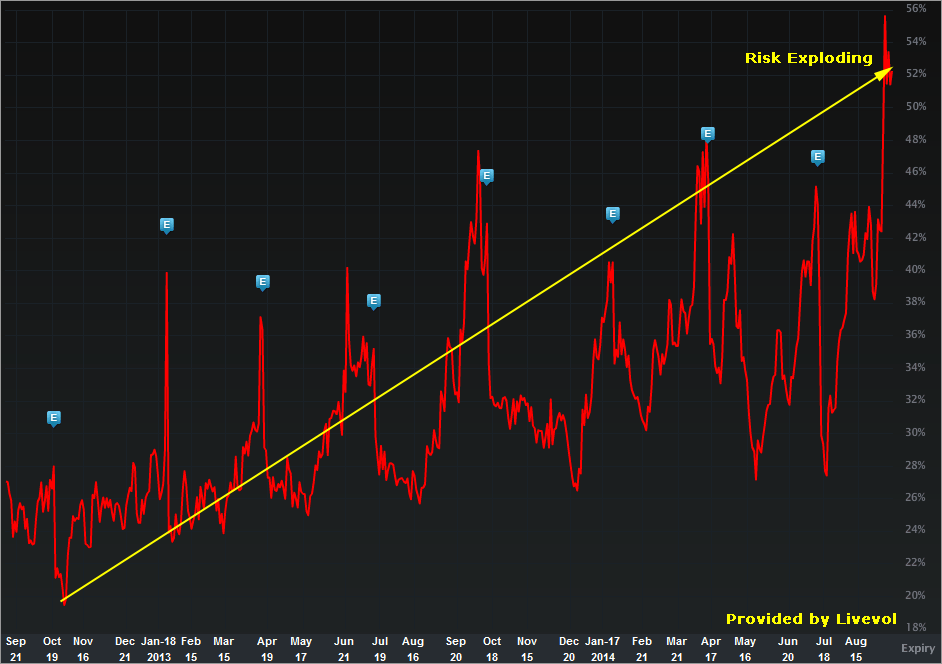
Provided by Livevol
The implied volatility is the forward looking risk in the equity price as reflected by the option market (IV30™ looks forward exactly 30 calendar days).
In English, the red curve is the risk in future stock price movement. The risk levels we see today are essentially unprecedented for YHOO, which means the BABA IPO is not the only question with this stock. In fact, we need to look at the fundamental measures to see that risk.
Revenue (TTM)
YHOO revenue has been in steep decline since 2008. In fact, in the 12 of the last 16 trailing twelve month periods, YHOO revenue have gone down. The peak was over $7.2B, right now the firm sits at $4.6B (TTM). Not good...

Operating Margins
One of my favorite measures of all is comparing operating revenue to operating expenses. Obviously a firm must have more than $1 in Op.Rev for every dollar in Op. Ex to be profitable. YHOO has fallen dangerously close to that threshold, with margins declining rather substantially.
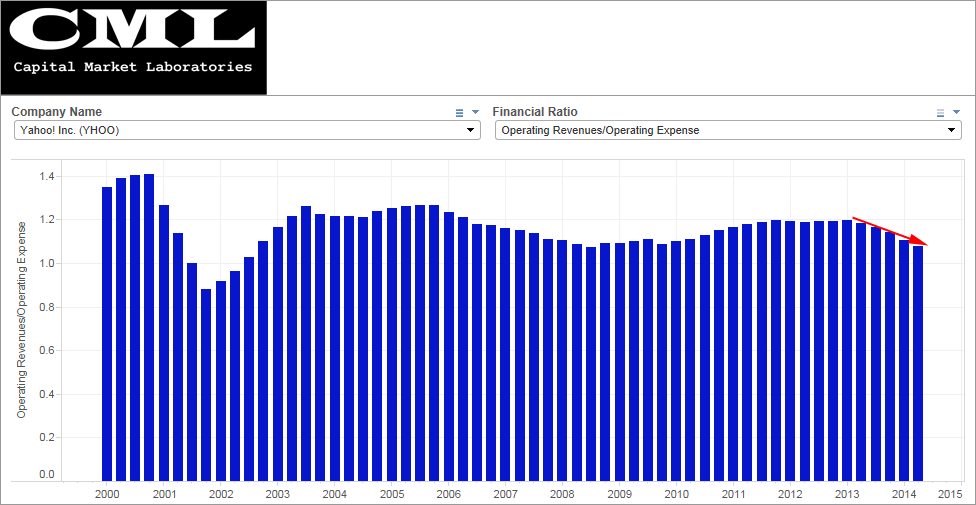
Now let's turn back to the option market and risk. The Skew Tab snap (below) illustrates the vols by strike.
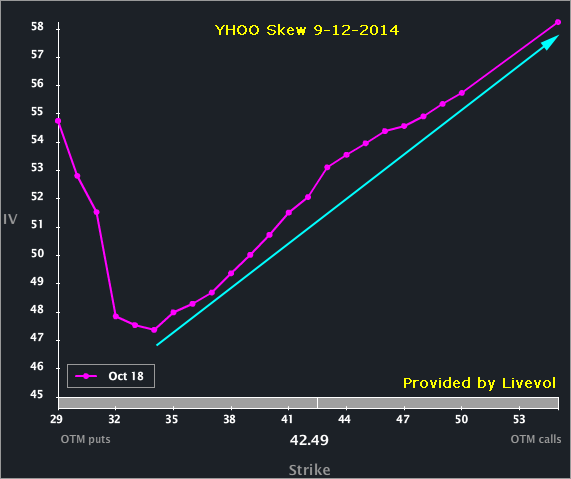
Provided by Livevol
I've included only the Oct monthly options. Check out that skew shape. The out-of-the-money (OTM) calls are priced to substantially higher volatility (risk) than the at-the-money (ATM) options. The option market reflects substantially elevated two-tail risk, and really, rather elevated upside risk (potential). This is not "normal" skew pricing.
So.. if it's not normal pricing, then what's going on? There are no absolutes here, but this type of skew shape is often seen in companies that are takeover candidates. YHOO has fallen into that category for years now and of course, it's still independent... But, the skew is sharply pointed to the upside, so don't rule out that possibility. That skew may also point to one of those 'crazy' IPO days, reflecting the possibility that BABA doesn't open at 470 (or whatever), but rather substantially higher.
To read more about skew, what is and why it exists you can click the title below:
Understanding Option Skew -- What it is and Why it Exists.
Finally, the Options Tab is included below.
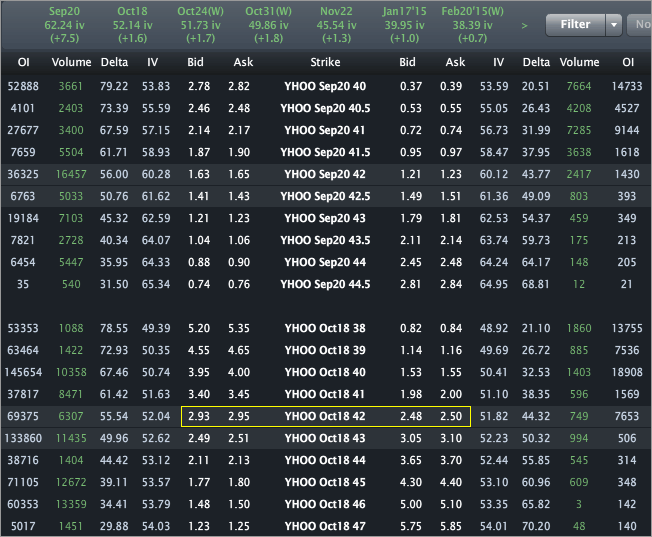
Provided by Livevol
Using the at-the-money (ATM) straddle we can see that the option market reflects a price range of [$36.50, $47.50] by the end of trading on October 17th.
- If you believe the stock will be outside that range on expiry or any date before then, then you think the volatility is too low.
- If you believe that range is too wide, and that the stock will definitively be in that range on expiration, then you think volatility is too high.
- If you're not sure, and can make an argument for either case, then you think volatility is priced just about right.
This is trade analysis, not a recommendation.
Follow @OphirGottlieb
Tweet
Legal Stuff:
Options involve risk. Prior to buying or selling an option, an investor must receive a copy of Characteristics and Risks of Standardized Options. Investors need a broker to trade options, and must meet suitability requirements.
The information contained on this site is provided for general informational purposes, as a convenience to the readers. The materials are not a substitute for obtaining professional advice from a qualified person, firm or corporation. Consult the appropriate professional advisor for more complete and current information. I am not engaged in rendering any legal or professional services by placing these general informational materials on this website.
I specifically disclaim any liability, whether based in contract, tort, strict liability or otherwise, for any direct, indirect, incidental, consequential, or special damages arising out of or in any way connected with access to or use of the site, even if I have been advised of the possibility of such damages, including liability in connection with mistakes or omissions in, or delays in transmission of, information to or from the user, interruptions in telecommunications connections to the site or viruses.
I make no representations or warranties about the accuracy or completeness of the information contained on this website. Any links provided to other server sites are offered as a matter of convenience and in no way are meant to imply that I endorse, sponsor, promote or am affiliated with the owners of or participants in those sites, or endorse any information contained on those sites, unless expressly stated.


No comments:
Post a Comment